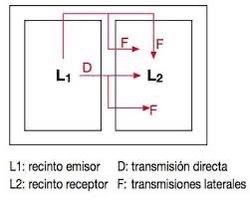In the acoustics industry, it is crucial to tell the difference between acoustic isolation and sound conditioning, because both of them play fundamental but different roles in the management of an acoustic space. In today’s article, we explain this in detail with the help of our experts in acoustic quality. Read on!

Acoustic isolation: Definition
Acoustic isolation is the combination of engineering techniques and the correct use of different materials with the goal of minimizing the transmission of outside sound, music, noise or vibration to the inside of a building, or from within a building itself to the inside of a specific room, be it either through the walls, ceiling, flor or ventilation pipes. When soundwaves make contact with a structural element, part of the energy is reflected outwards and the rest of it is absorbed, depending on the used materials. The measuring unit in this procedure is the decibel (dB).
This sound transmission process englobes different methods:
- Air transmission: It involves sounds that travel through air, such as voice and music, and are spread directly through surfaces such as walls, ceilings or floors.
- Indirect transmission: It happens when sound is propelled through adjacent surfaces, affecting other walls, ceilings or floors.
- Structural impact transmission: Generated by motions that directly impact the building’s structure, such as steps, the use of electrodomestics or air conditioning systems.
- Residual transmission: Through openings like ventilation pipes, blinds or holes in doors and windows.
In order to improve acoustic isolation, a variety of actions can be carried on, such as fixing or replacing deteriorated windows, improving the composition of the walls, or installing acoustic doors and windows systems. In cases of higher necessity, a completely detached room can be built with a floating structure that minimizes the transmission of vibration.
En casos de mayor exigencia, se puede construir una sala completamente desacoplada con una estructura flotante que minimice la transmisión de vibraciones.
Acoustic conditioning: Meaning
The acoustic conditioning of a room revolves around raising the acoustic comfort within said room, with the goal of improving the intelligibility of studios or meeting rooms or improving its musical reproduction quality.The aim is to find balance for the listener, allowing all frequencies to be heard naturally and without distortion.
The recommendations for acoustic conditioning will vary depending on the intended use of the space:
- Common spaces: Minimal acoustic absorption can suffice for areas such as schools.
- Music halls: 10% of the surface covered by sound absorbing material is necessary for acceptable hearing.
- Recording or rehearsal rooms: Between 20 and 40% absorption.
- Audiovisual production: Between 40 and 60%.
- Voice recording: Between 60 and 100% of surfaces covered by absorbing materials (walls and ceilings always included). For the floor, we recommend avoiding the use of a carpet -or similar items- in all of its surface, only on certain occasions and for decorative purposes.
Acoustic conditioning is also focused on achieving an adequate reverberation time, which is the amount of time that it takes the sound to diminish its intensity by 60 dB’s after the sound source has ceased. Reverberation must be adjusted according to the specific use of the space and its volume.
Differences between Sound Isolation and Acoustic Conditioning
Although both concepts are related, their goals and methods are different:
Acoustic Isolation:
- Prevents transmission of sound from one space to another one.
- Utilizes dense materials and structural detachment methods.
- It is essential to comply with local regulations and avoid noise problems for neighbors.
Acoustic Conditioning:
- Improves the quality of sound within a space.
- Utilizes light and porous materials that absorb the sound.
- It focuses on achieving adequate reverberation time for the intended use of the space.
An acoustically isolated space tends to have greater reverberation because sound cannot exit the room and remains inside that space. That is why it is common to need extra acoustic conditioning in rehearsal or musical production spaces.
Here at Mas Acoustics we are experts in acoustic conditioning for TV sets, recording studios and many different types of workplaces of the audiovisual sector.
Why is acoustic treatment important?
Acoustic treatment is fundamental for various purposes:
- Education: In classrooms or meeting rooms, it improves the intelligibility of speech, easing the process of learning and communicating.
- Music and audiovisual production: It ensures that recordings and plays are of the highest quality, with an organic and balanced sound.
- Amusement and work spaces: In offices, restaurants and other public spaces, it reduces the background noise and improves the acoustic comfort, creating nicer and more productive environments.
In summary, while acoustic isolation is fundamental to control the transmission of sound between spaces, acoustic conditioning is vital to guaranteeing an optimal auditory experience inside any kind of space. Both aspects must be carefully considered during the design and construction of any space that requires effective acoustic care.




